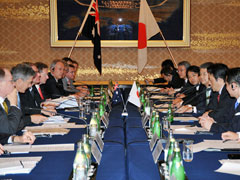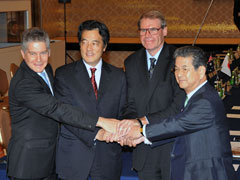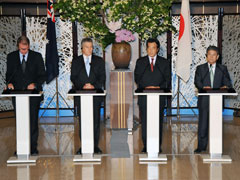The Summary of the Third Japan-Australia
Joint Foreign and Defense Ministerial Consultation
May 19, 2010
Japanese



[Date] May 19, 2010, 6:00-7:30pm, 8:00-9:30pm
[Attendants] On the Japanese side, Mr. Katsuya Okada, Minister for Foreign Affairs and Mr. Toshimi Kitazawa, Minister of Defense. On the Australian side, the Hon. Stephen Smith, MP, Minister for Foreign Affairs and Senator the Hon. John Faulkner, Minister for Defence
1. Overview
The Ministers confirmed that the roles Japan and Australia play for the peace and stability in the dynamically changing Asia-Pacific region is increasing, and agreed to further strengthen their coordination.
2. Japan-Australia Bilateral Security Cooperation, including the signing of the Japan-Australia ACSA
(2)The Japanese side stated it was preparing to dispatch military liaison officers to the United Nations Integrated Mission in Timor-Leste (UNMIT), and were seeking to support peace-building in Timor-Leste together with Australia, which is playing a central role in assistance to Timor-Leste, when the dispatch is realized. In response, the Australian side welcomed the dispatch by Japan and expressed its willingness to assist Japan in this regard.
(3)Both sides agreed to accelerate the ongoing negotiations of the Japan-Australia information-security agreement.
3. Japan-Australia-US Trilateral Cooperation
Both sides shared recognition that the US presence continues to be indispensable in the Asia-Pacific region, and agreed to deepen consultations and cooperation on the security strategy in the region through the Japan-Australia-US trilateral framework.
4. Korean Peninsula: the sinking of a South Korean patrol ship
Both sides discussed the incident of sinking of a South Korean military patrol vessel. They expressed their appreciation that South Korea was taking a calm stance on the incident, by responding to the incident based on a scientific and objective investigation conducted with participation by experts from other countries including Australia. Both sides agreed to support South Korea, following findings of the investigation to be soon released.
5. Nuclear-Disarmament and Non-Proliferation
Both sides confirmed the achievement of the bilateral cooperation toward a world without nuclear weapons, and agreed to cooperate further to take leadership in this field, taking into account outcomes of the NPT Review Conference.
6. Regional Architecture
The Australian side stated that it is important to build a regional architecture that would include major regional powers such as the US in the dynamically changing Asia-Pacific region from medium- and long-term perspectives. In response, the Japanese side stated that it was proposing the East-Asian Community as a long-term vision, while upholding the Japan-US alliance as a cornerstone. The Japanese side also stated that open and transparent regional cooperation is important, taking advantage of existing frameworks including EAS, ASEAN +3, ARF, and APEC, in a multifaceted and flexible manner.
7. Regional Issues
Both sides discussed their efforts for the stabilization of Afghanistan and Pakistan. In particular, they agreed that the reconciliation and reintegration of former Taliban soldiers is an important undertaking. In this regard, both sides appreciated their financial contribution to the Reintegration Trust Fund, and shared the recognition that such assistance in non-military areas continues to be important.
(2) Iran
Both sides confirmed that they shared concerns for Iran's nuclear issues and agreed to closely coordinate with countries concerned and the UN Security Council, taking into account recent developments concerning Iran
(3) Myanmar
Both sides agreed that it is important to continue to encourage Myanmar to realize a fair and democratic election that meets the expectations of the international community.
Back to Index
